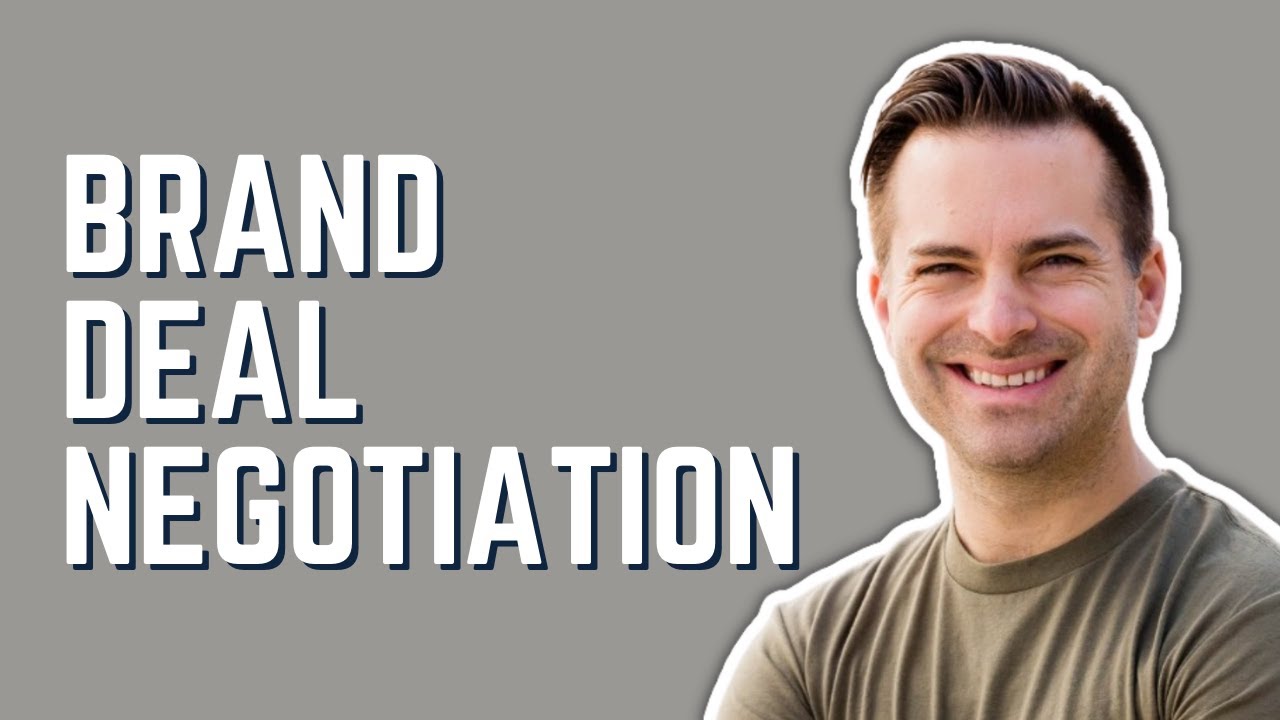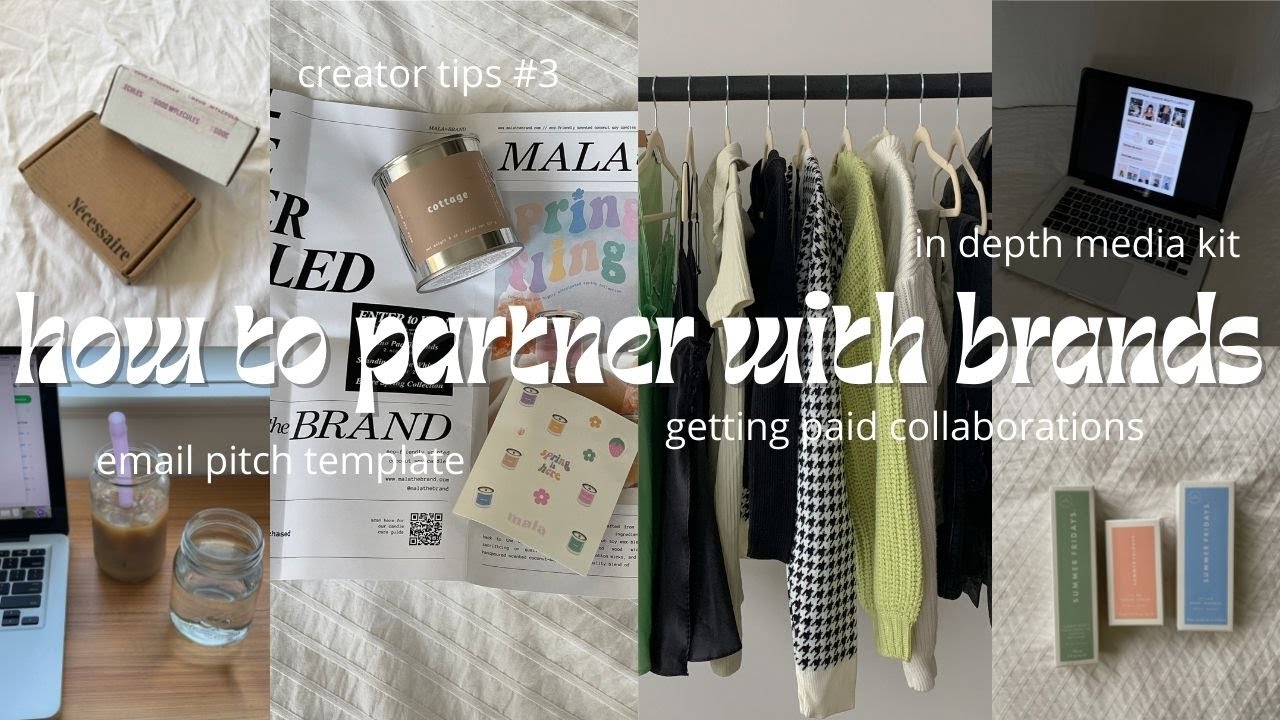 Ronald Aug . March 20
Ronald Aug . March 20
Negotiating With Brands
Approaching Brands for Sponsorships

Approaching Brands for Sponsorships
In today's competitive online landscape, having the best content is not enough – creators need to collaborate with brands and secure sponsorships to maximize their outreach and grow their channel. This section outlines the key steps, strategies, and tips on creating an effective sponsorship proposal for YouTube.
Before approaching brands for sponsorships, it's vital to understand your unique value proposition. What sets your channel apart? Here are some critical factors to consider:
- Audience Demographics: Who are your viewers (age, gender, location, interests)?
- Subscriber Count: How many loyal fans do you have?
- Average Views: How many views do your videos typically receive?
- Engagement Rates: What is your average like-to-dislike ratio, comment count, and CTR (Click-Through Rate)?
b) Researching Brands and Sponsorship Opportunities
The next step in crafting an effective proposal is to research potential sponsors and their requirements. This can be done by browsing through the company's website, analyzing their current sponsorships, and identifying the most suitable brands to approach.
Some tips for finding the right sponsors:
- Align with your niche: Sponsors should be relevant to your content and audience.
- Study the market: Know the sponsors of similar channels and do not approach direct competitors.
c) Structuring Your Proposal
The final step is to structure your sponsorship proposal, covering essential elements such as:
- Introduction: Briefly introduce your channel, niche, and target audience.
- Value Proposition: Clearly outline the benefits the brand will receive by sponsoring your channel, such as increased exposure, reach, and credibility.
- Audience Demographics: Provide detail on your audience's demographics to help the brand understand if you are a good fit for their target market.
- Performance Metrics: Include relevant stats such as subscriber count, average views, engagement rates, and growth trajectory.
- Sponsorship Options: Detail the types of sponsorships you offer, including product reviews, sponsored videos, social media shoutouts, contests, and more.
- Pricing: List the costs associated with each type of sponsorship–consider factors such as production time, complexity, and the brand's budget.
- Testimonials: Include quotes, video clips, or case studies from previous successful partnerships, if available.
- Contact Information: Provide clear contact details for further discussion.
Some essential tips for creating a winning proposal:
- Do use a professional tone and writing style.
- Do be concise and highlight key selling points.
- Do personalize each proposal for the specific brand.
- Do include data to support your performance claims.
- Don't use a generic template that lacks personalization.
- Don't exaggerate your abilities or reach – brands can verify your metrics.
For more resources on how to grow your YouTube channel, consider checking out these online courses and educational resources to develop your video creation skills further.
Creating a Professional Media Kit
Key Components
- Introduction and Channel Overview: Give a brief introduction to your channel, including its mission, content focus, and target audience. Highlight any significant achievements or milestones.
- Channel Statistics: Showcase your channel's performance metrics, such as subscribers, views, watch time, and engagement rate. Use charts or graphs for visual appeal and easy comprehension. Make sure to keep this information updated regularly.
- Audience Demographics: Provide information about your audience, including age, gender, geographical location, and interests. Use tables or charts to present this data in an organized manner.
- Past Partnerships and Testimonials: List the brands or companies you have collaborated with before and share any positive feedback or case studies from those partnerships.
- Sponsorship Opportunities and Rates: Specify the types of sponsorship opportunities you offer, such as video mentions, product reviews, or sponsored series. Include pricing information or ranges, which can be tailored based on factors such as video length, exclusivity, and audience reach.
- Contact Information: Include your email address, social media handles, or any other preferred method of contact.
- Do keep your media kit concise, clear, and professional.
- Do use high-quality images, legible fonts, and consistent branding.
- Do update your media kit regularly to reflect your current channel statistics and content.
- Don't overload your media kit with unnecessary information or clutter; only include relevant and compelling data.
- Don't exaggerate your channel's accomplishments or falsify data; always be truthful and transparent.
- Don't be afraid to showcase your channel's unique qualities and niche appeal, as brands may be interested in targeting specific audiences.
Several resources and templates can help you create a professional media kit tailored to your needs and style. Some popular options include Canva, Adobe Spark, and Affinity Publisher. Additionally, you can also find inspiration in the media kits of successful YouTubers and adapt their design and content approach.
Further Resources
Refer to our guide on how to make YouTube videos for tips on creating high-quality content that can enhance your media kit's appeal. To strengthen your portfolio of sponsorships, explore our resources on YouTube collabs and finding sponsors.
By creating a professional media kit, you showcase your value and potential as a YouTube creator in a visually engaging and organized manner, increasing your chances of securing brand sponsorships and collaborations.
Establishing initial contact and communication
Establishing Initial Contact
Reaching out to potential sponsors can be daunting, but this process can also open doors for fruitful partnerships. Here are some recommendations for establishing initial contact with potential sponsors:
Do Your Research
Before contacting brands, familiarize yourself with their products and services. Know their goals and target audience to better understand if your content aligns with their objectives. Look for {keywords for youtube}brand-related keywords in their marketing materials, blog posts, and social media profiles. Understanding a brand's values and objectives can help you tailor your pitch and make it more convincing.
Develop a personalized email
Crafting a personalized email can capture the attention of potential sponsors. Mention any common objectives or shared values between their brand and your content. If possible, explain how their product or service has benefitted you personally and how your audience might benefit from it too.
Opt for clear, concise communication
Make your message easy to read and understand. Keep your email concise while covering the necessary information – who you are, what you do on your YouTube channel, why you are interested in partnering with them, your proposal, and how your collaboration could benefit both parties.
Be polite and professional
Approach your potential sponsors with a courteous tone. Keep your language formal but friendly, and maintain a sense of professionalism in your communication.
Follow up if necessary
If you haven’t heard back from a potential sponsor after some time, you may want to follow up with a polite email to remind them of your proposal. It’s not uncommon for emails to get overlooked or lost, so a gentle reminder could get your email the attention it deserves.
Building a Relationship with Brands
Once initial contact is established, focus on creating a strong and lasting relationship with your potential sponsor. This can include:
- Regular updates: Keep your sponsors informed on the progress of your collaboration and provide them with metrics to show the impact of your work together.
- Open communication: Establish a clear line of communication, ensuring that both parties feel comfortable discussing any concerns or suggestions. This transparency builds trust and strengthens relationships.
- Show appreciation: Express gratitude to your sponsors for their support. A simple thank you email or shout-out in a video can go a long way in maintaining a positive relationship.
- Ask for feedback: Invite your sponsors to provide feedback on your collaboration and explore ways to improve it. This demonstrates your commitment to making the partnership as successful as possible.
Following these guidelines can help you establish strong relationships with brands, leading to successful sponsorships and a flourishing YouTube channel. Remember to always prioritize giving value to your audience, as this is the key driver of your channel's success. For more tips on growing your YouTube channel, check out these resources on how to make YouTube videos.
| Best Practices for Initial Contact | Don'ts |
|---|---|
| Personalized emails | Sending mass emails to multiple brands |
| Concise, clear communication | Writing long, complex messages |
| Polite, professional language | Using informal, casual tone |
| Keyword-research for aligning brand values | Ignoring or misrepresenting brand values |
| Follow up after an appropriate time | Sending continuous follow-up emails |
Best Practices for YouTube Sponsorship Negotiations


 Josh Spector
Josh Spector
Best Practices for YouTube Sponsorship Negotiations
Common pitfalls to avoid in negotiations
Not doing thorough research
A key aspect of successful negotiation is understanding the brand you are partnering with and aligning your values and content with their offerings. Therefore, it is crucial to research the brand's products, services, and target audience. Not doing so may lead you to accept a sponsorship that isn't valuable to your channel or could damage your reputation.
Lack of preparation
Prepare for the negotiation by knowing your worth, establishing your objectives, and setting clear boundaries for the partnership. This includes understanding the types of content, frequency, and duration of the sponsorship. Without preparation, you may agree to terms that leave you overworked or undervalued.
- Do: Calculate your average view count and engagement rates, and understand market rates for sponsorships
- Don't: Accept the first offer without knowing your worth or comparing it to similar offers
Ignoring FTC regulations
Advertisers and creators must adhere to Federal Trade Commission (FTC) guidelines regarding disclosure of sponsored content. Failing to disclose a sponsorship adequately can lead to fines and damage your channel's reputation.
Overpromising and underdelivering
Promising results or content quality you cannot deliver can leave the sponsor disappointed and potentially harm your long-term relationships. Set realistic expectations for both parties to create a successful and mutually beneficial partnership.
- Do: Set achievable goals and communicate your sponsorship terms clearly
- Don't: Promise overly ambitious results or additional content without considering your capacity
Neglecting to establish clear communication processes
Communication is essential throughout the negotiation process and the duration of the partnership. Ensure that you have clear communication channels with the brand and clarify any terms or expectations that are ambiguous.
Focusing solely on monetary compensation
While monetary compensation is significant, it is crucial to consider other factors that might benefit your channel, such as exposure, long-term partnerships, or product offerings. Negotiate a well-rounded deal that will benefit both parties.
Not having a backup plan
Entering negotiations without a backup plan or alternative options can lead to settling for less than ideal terms or failing to reach an agreement altogether. Having a backup plan enables you to have more leverage during negotiations and maintain a strong position.
By avoiding these common pitfalls in sponsorship negotiations, you'll be on the right path to forming successful and long-lasting partnerships that will benefit your YouTube channel's growth. Remember that knowledge, preparation, and communication are key aspects of successful negotiations.
Best Practices for YouTube Sponsorship Negotiations
#### Learning from successful creator-brand partnerships
-
Casey Neistat and Samsung: The smartphone company partnered with the popular creator to produce a series of videos showcasing their products. The collaboration was highly successful, with the branded videos reaching millions of views.
-
Dude Perfect and Nerf: The popular sports and comedy channel Dude Perfect has partnered with Nerf on numerous occasions to feature the company's products in their videos. The success of these partnerships has led to the creation of exclusive product lines for the creator.
-
Safiya Nygaard and ColourPop: The beauty creator collaborated with the makeup company ColourPop to create a line of lipsticks. The collection was very successful, with many products selling out shortly after its release.
-
Marques Brownlee and Tesla: The tech reviewer Marques Brownlee, also known as MKBHD, partnered with Tesla to showcase the car company's electric vehicles and technology in his videos. This collaboration generated significant buzz and increased the brand's awareness among tech enthusiasts.
DO
- Set realistic expectations for both the creator and the brand.
- Clearly outline terms of the agreement, including compensation, posting schedules, and required content features.
- Research the brand and ensure that the partnership aligns with the creator's image and target audience.
- Maintain open lines of communication with the brand to address any concerns or issues throughout the collaboration process.
- Utilize data and analytics to showcase the benefits of the partnership to the brand, such as increased exposure, traffic, and sales.
DON'T
- Accept partnerships with brands that are not aligned with the creator's content and values.
- Overpromise and under-deliver on content or results, which can harm both the creator's reputation and their relationship with the brand.
- Neglect analytics and results measurements, as they are critical for evaluating and improving future collaborations.
Additional Resources
To further expand your knowledge on working with brands and negotiating sponsorship deals, you may also want to explore the following courses and resources:
- How to Make YouTube Videos - Online Courses and Educational Resources
- Find Sponsors - Navigating the Business of YouTube Sponsorships
- What to Charge Brands - Guide for Sponsorship Pricing
By implementing the best practices and strategies discussed in this section, you can ensure that your YouTube creator-brand partnerships are successful, profitable, and beneficial to all parties involved.
Best Practices for YouTube Sponsorship Negotiations
Staying up-to-date with industry trends and guidelines
As a YouTube content creator, it's essential to keep up with the latest industry trends and guidelines for successful sponsorship negotiations. These best practices will help you understand the current landscape, create a realistic negotiation strategy, and foster a successful and profitable collaboration with sponsors.
Stay informed about the latest YouTube creator news and trends to understand how the industry is evolving. Here are some current stats:
- YouTube's mobile revenue grew by 50% in 2020, highlighting the importance of optimizing content for multiple devices.
- Sponsorship revenues are expected to grow in coming years as brands increase their influencer marketing budgets.
Do:
- Establish clear goals and expectations for the partnership
- Research the sponsor's brand values, history, and target audience
- Maintain open and transparent communication with the sponsor
- Keep the sponsorship content authentic and in line with your channel's tone and values
- Disclose sponsored content to your audience and comply with YouTube's ad policies and ethical guidelines
Don't:
- Agree to unfavorable terms or unrealistic expectations
- Let the sponsor dictate your entire content approach
- Promote products or services you don't believe in or haven't thoroughly tested
- Make misleading or deceptive claims about the sponsor or their products
- Violate YouTube's community guidelines or policies
-
Stay active in YouTube creator communities, participate in industry-specific events, and attend workshops or conferences. Networking with other creators can lead to valuable insights and tips for successful sponsorship negotiations.
-
Utilize online resources to learn more about influencer marketing trends and strategies, such as how to make YouTube videos that are professional and engaging.
-
Research potential sponsors by exploring their social media presence, customer reviews, and browsing their websites. This can help you identify the sponsor's target audience and assess whether there is a good fit with your channel.
-
Review your channel's engagement and performance metrics to provide potential sponsors with accurate data and demonstrate your channel's value. This includes your number of subscribers, average watch time, and demographic information about your viewers.
-
Create a professional-looking media kit that highlights your channel's success and lays out the key benefits and perks that sponsors can expect by working with you.
-
Be prepared to negotiate rates, terms, and deliverables. Know what you're willing to compromise on and which aspects are non-negotiable. Remember to consider the larger picture – a lower initial rate might be acceptable if the deal includes long-term collaboration, multiple sponsored videos, or additional exposure for your channel.
-
Keep up-to-date with legal guidelines, such as FTC regulations for sponsored content and YouTube's advertising policies. Familiarize yourself with copyright laws and avoid copyright strikes by using royalty-free music and stock footage in your videos.
By staying informed and following these best practices, you can successfully navigate the world of YouTube sponsorships and make the most of your channel's potential. As a content creator, your ability to stay up-to-date and adapt to industry changes will make all the difference in your long-term success.
Evaluating and Maintaining Sponsorship Relationships
- Measuring the success of sponsored content
- Kick Off Strong Communication
- Set Clear Expectations
- Show Appreciation
- Results and Analysis
- Seek Feedback and Adapt
- Be a Reliable Partner
- Network and Collaborate
- Providing Value and Reporting to Sponsors

Evaluating and Maintaining Sponsorship Relationships
Measuring the success of sponsored content
Key metrics to measure
To effectively measure the success of sponsored content, you should consider the following key metrics:
- Views: The number of times your video has been watched
- Watch time: The total amount of time users spent watching your video
- Engagement: Likes, comments, and shares for your video
- Click-through rate (CTR): The percentage of viewers who clicked on your sponsored content
- Conversion rate: The percentage of users who completed an action (purchase, sign-up, etc.) after engaging with your sponsored content
- A product review video with more than 1 million views, high engagement, and a high conversion rate for the sponsored product
- A sponsored video that led to increased sales of the product and a high CTR to the best tools for YouTube creators
- A how-to video that features a sponsored product and results in a significant increase in sign-ups for the brand's service
Do's:
- Do disclose the fact that your content is sponsored
- Do create high-quality and valuable content that resonates with your audience
- Do track and analyze the performance of your sponsored content
- Do maintain a good relationship with your sponsors by updating them on the results of your collaboration
Don'ts:
- Don't create content that doesn't align with your brand or channel's mission
- Don't solely focus on views; consider other metrics such as engagement and conversion rate
- Don't forget to respond to comments and concerns from your audience regarding your sponsored content
- Don't rely solely on sponsorships for your channel's revenue; consider growing your YouTube channel in other ways
Use charts and tables to visualize your sponsored content performance. Tracking your results over time can help you make more informed decisions about future sponsorships. You can create these visuals using tools like Excel or Google Sheets, or consider using analytics tools built specifically for YouTube creators.
Remember to check out our tools and services for creators to help you succeed in your YouTube journey.
Nurturing Long-Term Partnerships
Building and maintaining long-term partnerships with sponsors is essential for a successful YouTube channel. A solid collaboration can lead to increased revenue, better content, and a stronger online presence. In this section, we'll discuss various strategies for nurturing long-term relationships with sponsors.
Kick Off Strong Communication
From the very beginning, establish robust and open communication with sponsors. Transparency and constant dialogue will build trust and pave the way for long-term partnerships. Keep sponsors in the loop by providing regular updates, discussing content strategies, and sharing feedback.
Set Clear Expectations
Clearly define and agree upon the roles, responsibilities, and expectations of both parties. By setting realistic expectations, you can avoid potential conflicts or misunderstandings. Make sure to revisit these terms periodically to ensure both parties are still aligned.
Show Appreciation
Express gratitude to sponsors and show them the value they bring to your channel. Showcase their brand and products in a positive, genuine light in your content. Highlight the brand to your audience and engage them through social media shout-outs and mentions.
Results and Analysis
Regularly monitor and share the performance of your sponsored content with your sponsors. Provide data-driven insights to help them understand the impact of their investment. Discussing analytics can help identify areas for improvement.
Seek Feedback and Adapt
Actively seek feedback from sponsors and be open to criticism. Use their feedback to improve your content and overall partnership. Don't be afraid to pivot and adapt to meet the evolving needs of your sponsors.
Be a Reliable Partner
Always deliver on your promises and follow through on your commitments. Consistently providing quality content and meeting deadlines demonstrates professionalism and helps establish trust.
Network and Collaborate
Grow your relationships with sponsors by attending industry events, networking with other creators, and seeking additional collaboration opportunities. Building a professional network will lead to new sponsorship opportunities and strengthen existing partnerships. Check out our section on YouTube collabs to find ways to connect with other creators.
By following these best practices, you'll be well on your way to cultivating long-term partnerships and capitalizing on lucrative sponsorship opportunities. Remember, great relationships lead to great results.
Providing Value and Reporting to Sponsors
In this section, we will discuss the importance of providing value to your sponsors and how to effectively report your results to maintain a strong and successful sponsorship relationship.
Providing Value to Sponsors
- Understand your sponsor's goals: In order to provide value to your sponsors, it is crucial to understand their goals and objectives. This will help you shape your content to meet their expectations and enhance their overall experience.
- Authenticity: Stay genuine and authentic while promoting a sponsor's product or service. This will create trust and rapport between you, your audience, and the sponsor.
- Relevance: Align your content with the sponsor's niche or industry, as this will create a seamless integration for your audience.
- Engagement: Encourage your audience to interact with sponsored content by asking questions, commenting, or sharing their opinions.
Reporting to Sponsors
- Regular communication: Maintain open communication with your sponsor by providing regular updates on your progress and any achievements or milestones.
- Metrics and statistics: Present clear, concise, and accurate metrics, such as views, watch time, engagement, and conversions to illustrate the effectiveness of the sponsored content.
- Screenshots and visual aids: Enhance your reports by including screenshots, graphs, and charts that visually represent your results and provide valuable insights for your sponsor.
- Context and analysis: Along with raw data, provide context and analysis to explain the significance of your results and how they correlate with the sponsor's goals and objectives.
- Don't exaggerate or manipulate data: Be honest and transparent in your reporting. False or manipulated information will ultimately damage your relationship with the sponsor.
- Overview of the sponsored content performance
- Performance indicators:
- Views
- Watch time
- Engagement (likes, comments, shares)
- CTR (if applicable)
- Conversions (if applicable)
- Screenshots and visual representation of the data
- Comparative analysis (comparison with previous sponsorships or similar content)
- Final thoughts and recommendations for future collaborations
To enhance your YouTube channel and increase your chances of attracting high-quality sponsors, consider checking out this resource on how to make YouTube videos.
Negotiation Strategies and Techniques


 Big Think
Big Think
Negotiation Strategies and Techniques
Determining your value and pricing
Before entering any negotiation with brands or sponsors, you must first determine your value and pricing. In this section, we will cover important factors to consider when determining your value, key metrics to evaluate, and strategies to price your services effectively.
-
Subscriber count: A key metric in determining your value is your YouTube subscriber count. It signifies your reach and, for many sponsors, your potential customer base.
-
View count: The number of views on your videos is another metric that can influence your pricing. Higher view counts indicate higher engagement and reach.
-
Engagement: Analyze the number of likes, comments, and shares on your videos to understand how your audience engages with your content. This can be indicative of your audience's responsiveness to potential sponsorships or collaborations.
-
Audience demographics: Your audience's age, gender, and location can help you in targeting specific brands or sponsorships. Some brands may target specific markets, so having a strong presence in those demographics can increase your value.
-
Niche and expertise: Your niche and expertise in your field may make you more attractive to specific brands or sponsors. Demonstrating your knowledge and expertise can further establish your value.
- A large follower base or a high engagement rate can justify higher pricing for sponsored videos or collaborations.
- Being an expert in a specific niche may command a premium over generalist influencers. Brands often look for influencers who can provide authority in their chosen field.
Do's
- Research similar YouTubers in your niche to understand their value and pricing.
- Communicate your value and key metrics to potential sponsors clearly and professionally.
- Continually reassess and update your value and pricing as your channel grows or enters new markets.
Don'ts
- Don't undervalue yourself. Consider all aspects of your YouTube presence before determining your pricing.
- Don't inflate your metrics. Transparency with potential sponsors can help establish trust and long-lasting relationships.
Create a table or chart with your key metrics (e.g., subscriber count, views, engagement rate, etc.) to display your strengths and showcase your value to potential sponsors.
Pricing Strategies
- Cost-per-thousand (CPM) model: Charge based on the number of views on your videos. This model is useful if you have a large following or high engagement.
- Flat fee: Charge a fixed fee for sponsored videos or collaborations. This can be an effective model for small to medium-sized channels.
- Tiered pricing: Offer a range of pricing options based on the level of exposure or involvement in the campaign (e.g., a shoutout in a video vs. a dedicated video). This provides flexibility for brands with varying budgets and needs.
Remember to factor in the time and effort required to create content and manage the partnership when determining your pricing.
For more information on creating YouTube videos, check out "How to Make YouTube Videos".
Establishing Mutually Beneficial Terms
Establishing mutually beneficial terms for negotiations is essential for YouTube creators. Whether negotiating with collaborators, sponsors, or brands, the goal is to reach agreements that are beneficial for all parties. This is a vital part of ensuring creators can maintain a successful channel and secure profitable partnerships. In this section, we'll explore various strategies and techniques to achieve this goal.
Statistics on Successful Negotiations
Knowing the potential benefits of successful negotiations can encourage creators to invest more time in mastering the art of negotiation. Here are some statistics showcasing the advantages of effective negotiation strategies:
- The Harvard Business Review found that negotiators who prioritize win-win outcomes are 10-13% more likely to succeed than those who focus on maximizing their own gains.
- According to data from YouTube collabs, creators who engage in successful collaborations see an average growth rate of 20% in their channel subscribers within three months.
-
Know your value: Understand the unique value you bring to the negotiation table. Consider factors like skills, audience reach, and engagement when establishing your worth in negotiations.
-
Research the other party: Learn about the other party's needs, goals, and concerns, and use this information to develop proposals that benefit both parties.
-
Prepare multiple options: Develop multiple potential terms that could benefit both parties, increasing the chances of finding common ground and achieving win-win solutions.
-
Practice active listening: Engage the other party in discussions and actively listen to their perspectives, demonstrating empathy and understanding for their concerns.
-
Find creative solutions: Seek opportunities for mutual benefits that may not be immediately apparent. Consider non-monetary benefits, like cross-promotion, access to resources, or sharing valuable connections.
-
Be open to compromise: Accept that not every negotiation will result in perfect arrangements for both parties, but strive for the most acceptable outcomes for all involved.
-
Set clear expectations: Communicate your objectives clearly and ensure that both parties understand the terms and implications of any agreements.
Do's:
- Engage in open communication and transparent dialogues
- Be willing to make concessions
- Show respect and understanding for the other party's interests
- Keep emotions in check
- Maintain a long-term perspective
Don'ts:
-
Focus exclusively on your own interests
-
Let ego dictate decisions
-
Make ultimatums or issue threats
-
Rely on deceptive tactics
-
Settle for deals that significantly compromise your value
-
SWOT analysis: A SWOT analysis is a helpful tool to identify your strengths, weaknesses, opportunities, and threats in negotiations. Knowing your skills and vulnerabilities will help inform your strategies and approaches.
-
Decision matrix: A decision matrix is a chart highlighting various potential outcomes, the likelihood of those outcomes occurring, and the potential impact on your channel or brand. This can help ensure informed decisions, especially in complex negotiations.
Establishing mutually beneficial terms is essential for YouTube creators when negotiating with collaborators, sponsors, or brands. By understanding your value, researching the other party, preparing multiple options, and practicing open communication and active listening, creators can engage in negotiations that result in win-win outcomes. Equipping yourself with the knowledge and techniques discussed in this section will greatly improve your negotiation skills. For more information on growing and optimizing your YouTube channel, check out our resources on how to make YouTube videos, and navigate through the challenges of the YouTube landscape.
Negotiation Strategies and Techniques
Key Statistics
- A study by Harvard Business Review found that negotiators who made ambitious opening offers achieved better outcomes, even if they faced rejection initially.
- According to the American Management Association, 70% of negotiators make a counteroffer after receiving an initial offer.
- PewDiePie's successful collaboration with G FUEL led to a long-term partnership that resulted in the creation of the popular PewDiePie flavor.
- Casey Neistat's deal with Samsung for the "DO WHAT YOU CAN'T" campaign elevated his reputation in the tech world and helped Samsung showcase their products in a creative way.
Do's
- Maintain a positive attitude and stay professional even if you receive a rejection.
- Take the rejection as a learning experience and ask for feedback to improve your negotiation skills.
- Be open to counteroffers and be willing to compromise, as long as it aligns with your values as a creator.
- Show flexibility in your demands and be ready to make concessions if it results in a win-win partnership.
- Practice active listening and show empathy towards the opposing party's concerns.
Don'ts
- Don't get discouraged by rejection or let it affect your self-confidence.
- Don't be too rigid in your demands or refuse to compromise.
- Don't engage in negative communication or try to manipulate the other party.
- Don't let your ego drive your decisions and jeopardize potential partnerships.
Table Recommended Steps to Handle Rejection and Counteroffers
| Step | Action |
|---|---|
| 1 | Evaluate the reasons for rejection and consider revising your offer |
| 2 | Show appreciation for the opportunity and keep the communication lines open |
| 3 | Assess the counteroffer and determine if it aligns with your goals |
| 4 | Make a revised proposal that addresses the other party's concerns |
| 5 | Close the deal and establish a long-term relationship |
Handling rejection and counteroffers is vital for successful negotiations, particularly for YouTube creators partnering with brands and collaborators. By understanding the essential do's and don'ts, gathering relevant data, and staying professional, you can turn rejections into opportunities and secure beneficial deals for your YouTube career.
For more assistance in developing your content creation skills, be sure to check out our guide on how to make YouTube videos.
Sponsorship Agreements and Contracts

Sponsorship Agreements and Contracts
Key elements of a sponsorship agreement
A sponsorship agreement is a legal contract between a brand and a YouTube creator that outlines the terms and conditions of the partnership. Here are the key elements of a sponsorship agreement:
Parties involved
Clearly identify the parties involved in the agreement, including their names, addresses, and contact information.
Sponsorship terms
Outline the duration and type of sponsorship, such as a one-time sponsorship, a series of sponsored videos, or an ongoing partnership.
Compensation
Detail the financial compensation, including the payment terms, payment schedule, and how it will be delivered (e.g., via PayPal, wire transfer, etc.). Additionally, include any non-monetary benefits, such as merchandise or access to exclusive events.
Content requirements
Specify the content requirements, such as the minimum length of the video, the placement of sponsor mentions, and any specific message or call-to-action that must be included.
Approval process
Outline the approval process for the sponsored content, including any deadlines for submission and the expected timeline for providing feedback and final approval.
Intellectual property rights
Define the intellectual property rights for the sponsored content, such as who owns the copyright and whether the brand can use the content for its marketing purposes.
Performance metrics
Establish the performance metrics that the sponsored content should achieve, such as the number of views, likes, or comments. This may be linked to bonus payments or future sponsorship opportunities.
| Metric | Target | Bonus |
|---|---|---|
| Video views | 50,000 | $500 |
| Likes | 5,000 | $200 |
| Comments | 500 | $100 |
Confidentiality and exclusivity
Include clauses on confidentiality to protect the sponsorship agreement details and exclusivity to prevent the creator from promoting competitors within a specified time frame.
Termination
Describe the conditions under which the agreement can be terminated, such as a breach of contract, failure to achieve performance metrics, or a change in the creator's content direction.
Governing law and dispute resolution
Specify the governing law for the agreement and any dispute resolution methods, such as mediation or arbitration, in case of disputes.
- Do ensure that both parties understand and agree to all aspects of the sponsorship agreement before signing.
- Do clearly outline expectations for content creation and performance metrics.
- Do research local laws and relevant YouTube guidelines to ensure compliance.
- Don't agree to unreasonable terms or unrealistic performance metrics.
- Don't sign a sponsorship agreement without consulting legal counsel if you are unsure about any aspect of the contract.
For more guidance on creating content for YouTube, check out these online courses and educational resources on how to make YouTube videos.
Protecting your interests and creative control
When it comes to YouTube sponsorships, ensuring that your interests and creative control are protected is crucial. In this section, we will explore various aspects of sponsorship agreements and how to navigate them while maintaining your unique voice as a content creator.
Sponsorship Agreement Basics
A sponsorship agreement is a legally binding contract between the content creator (you) and the sponsor (the brand). It outlines the terms and conditions of the sponsorship, including payment, deliverables, deadlines, and any specific requirements from both parties.
A well-crafted agreement provides clarity and protection for both parties, helping to avoid potential disputes down the line. Be sure to read and understand every clause in the contract before signing. If necessary, consult with a lawyer to ensure your interests are adequately protected.
Maintain Creative Control
One of the most important aspects of any sponsorship agreement is ensuring your creative control remains intact. Here are some tips on preserving your creative voice:
- Clearly define your content style and tone. Specify that the sponsor cannot demand changes that deviate from your established identity.
- Include a clause stating that you will maintain final approval on all sponsored content.
- Establish boundaries for sponsor input, such as providing feedback on a specific number of drafts before the final release.
Scope of Deliverables
Provide a clear list of deliverables in the contract, including the number of sponsored videos, social media posts, and any other content formats required by the sponsorship. Also, consider the following:
- Clearly state any deadlines for deliverables.
- Specify the platforms on which the sponsored content will appear.
- Define the extent to which the sponsor's brand will be featured in your content.
Payment Terms
Clearly outline the payment terms and conditions in the agreement, including:
- The payment amount and currency.
- The payment method, whether it's a one-time payment or based on milestones.
- Any potential penalties or discounts for early or late payment.
Do:
- Read and understand the entire contract before signing.
- Seek legal advice as needed.
- Clearly define deliverables and deadlines.
- Establish boundaries for sponsor input.
- Negotiate terms that maintain your creative control.
Don't:
- Sign an agreement that you don't fully understand.
- Give up control over your content.
- Agree to unreasonable deadlines or excessive workloads.
- Allow payment terms that are unfavorable to you.
- Be afraid to negotiate and stand up for your interests.
By following these best practices, you can ensure that your YouTube sponsorship agreements provide a solid foundation for successful partnerships while protecting your interests and creative control. For more resources on building a successful YouTube career, check out our YouTube creator news and other resources.
Importance of reviewing contracts
Reviewing and finalizing contracts is crucial in ensuring a successful and smooth business relationship between YouTube creators and sponsors. Properly reviewing and negotiating contracts can protect your rights as a creator, help avoid future disputes with sponsors, and allow both parties to enjoy the expected benefits.
Key contract clauses to review
Here are some important clauses that should be carefully reviewed before signing a sponsorship contract:
- Scope of work: Clearly outline the expectations, deliverables, and responsibilities for each party.
- Payment terms: Specify the payment amount, schedule, and the method of payment.
- Term and termination: Define the duration of the agreement and the conditions under which the contract may be terminated by either party.
- Exclusivity: Determine whether the creator is restricted from promoting competing products or services.
- Intellectual property rights: Establish the ownership of content, including copyrights, trademarks, and other intellectual property rights.
- Confidentiality: Outline the obligations for both parties to maintain confidentiality regarding the agreement and any sensitive information.
- Liability and indemnification: Set forth the limitations of liability and indemnification provisions in case of disputes, damages, or losses.
Do's
- Do consult with a legal expert if you are not familiar with contract terms and implications
- Do thoroughly review and understand every clause in the contract
- Do negotiate terms that are unfavorable or unclear
- Do communicate openly with the sponsor to discuss any concerns or questions you have
Don'ts
- Don't rush through the contract review process
- Don't sign a contract without fully understanding its terms
- Don't agree to terms that you are uncomfortable with
Once both parties have reviewed the contract and addressed any concerns, edits, or updates, it is time to finalize the agreement. Both parties should sign the contract, and each should keep a copy for their records.
Additional resources
To learn more about sponsorship agreements and other aspects of being a YouTube creator, check out these resources:
By understanding the importance of reviewing and finalizing contracts, YouTube creators can better protect their interests and ensure successful collaborations with sponsors. Always remember to carefully review and understand all contract terms, and consult with legal experts if needed.

Why Brand Collaborations Matter
- Financial Support: One of the main benefits of partnering with brands is the potential for increased revenue. These collaborations often involve sponsored content deals, product placements, or affiliate marketing opportunities.
- Higher Production Value: With financial support from a brand, creators can invest more in equipment, editing, and other resources to produce higher-quality content.
- Audience Growth and Engagement: Collaborating with a brand can lead to exposure to new audiences, creating opportunities for audience growth and increased engagement.
- Networking Opportunities: Partnering with brands can open the door to further collaborations and connections in the industry.
- In a study conducted by MediaCom, 84% of viewers trust videos with sponsored content, as long as the collaboration is authentic and provides value to the audience.
- Influencer Marketing Hub's report found that 84% of businesses believe in the effectiveness of influencer marketing and plan to invest in it within the next 12 months.
- Samsung's partnership with YouTuber Casey Neistat led to a series of high-quality videos showcasing the brand's products while staying in line with Neistat's creative style.
- Beauty YouTuber Nikkie de Jager (NikkieTutorials) collaborated with cosmetics brand OFRA Cosmetics to create a limited edition makeup collection, which not only generated revenue but also increased brand awareness for both parties.
Do's
- Research potential brand partners to ensure the collaboration aligns with your target audience and content.
- Establish clear expectations and communication channels with brand partners.
- Focus on authenticity and value when creating sponsored content.
- Comply with the YouTube sponsorship and endorsement guidelines.
- Disclose sponsored content to your audience and be transparent about the nature of the partnership.
Don'ts
- Partner with brands that do not align with your target audience or content.
- Sacrifice the quality or authenticity of your content for the sake of a collaboration.
- Neglect to disclose the sponsorship to your audience.
- Networking and building relationships: Attend industry events, join YouTube collabs forums, and stay active on social media to connect with potential brand partners.
- Creating a media kit and sponsorship proposal: Develop a professional media kit and sponsorship proposal to showcase your channel's performance, demographics, audience engagement, and collaboration ideas.
- Leveraging data and analytics: Use data from previous collaborations to demonstrate the value and impact of partnering with your channel.
- Continuously improving content quality: A strong portfolio of engaging and high-quality content is essential for attracting brands and maximizing the benefits of collaborations.
In addition to brand collaborations, consider exploring other resources to help grow and optimize your YouTube channel, such as websites for YouTube creators and YouTube optimization tools.
Types of YouTube Sponsorships
Sponsorships have become a vital source of income for many YouTube creators. As the platform continues to grow, understanding the different types of sponsorships available is crucial for any creator looking to partner with brands. This section will explore the various sponsorship types to help you choose the most suitable ones for your channel.
a) Integrated Sponsorships
Integrated sponsorships include a sponsor's product or service being integrated directly into a creator's regular content. This integration can be done in various forms, such as product reviews, in-video ads, or mentions.
b) Affiliate Partnerships and Ambassadors
In affiliate partnerships, creators promote a product or service with a unique link or code. They earn a commission for every sale or sign-up generated through that link. Brand ambassadors are creators who have an ongoing relationship with a brand and promote it regularly.
c) Channel Sponsorships
Companies can choose to sponsor an entire YouTube channel, usually in exchange for consistent promotion throughout the channel's content. This type of sponsorship provides long-term financial support for creators.
d) Ad Bumpers and Pre-Roll Ads
These are short video ads that play before or during a creator's video. Creators receive a portion of the ad revenue generated from these ads.
e) Giveaways and Collaborative Contests
Brands can partner with creators to host giveaways or contests for their viewers. This can be an effective way to promote a product and drive audience engagement.
Tips for a Successful Sponsorship
Do's
- Choose sponsors that align with your channel's content and audience.
- Disclose your relationship with the sponsor in compliance with FTC guidelines.
- Be transparent with your audience about sponsored content, maintaining their trust.
- Create high-quality sponsored content that showcases the product, service or brand in a way that aligns with your channel's style.
- Be open to negotiation with brands to ensure fair compensation and mutually beneficial contracts.
Don'ts
- Over-promote sponsored content to the point of alienating your audience.
- Endorse products or services that you do not genuinely believe in or use.
- Sign exclusive contracts that limit your ability to work with other brands.
- Ignore negative feedback or backlash from sponsored content, instead, use it as an opportunity to improve.
Knowing the types of YouTube sponsorships available can open up new opportunities for creators. By partnering with brands that align with your content, creators can build long-lasting relationships that benefit both parties. To optimize your content and learn how to create engaging videos, check out our guide on how to make YouTube videos.
Looking for Brand Deals or Channel Strategy?
We run a platform for brand deals and an agency, helping creators derive maximum value from their content, while offering brands access to unparalleled, best-in-class research.
For Creators
- Strategic Brand Connections
- Outreach to Old Sponsors
- Platform to Manage Brand Deals
- View-Based Contract Negotiation
- Comprehensive Channel Strategy
- Channel/Thumbnail Optimization
For Brands
- Tools to Shortlist Creators
- Targeted Creator Outreach
- Detailed Sponsorship Reports on Existing Brands
- Platform to Manage Creator Deals
- View-Based Deal Facilitation
For Creators
- Strategic Brand Connections
- Outreach to Old Sponsors
- Platform to Manage Brand Deals
- View-Based Contract Negotiation
- Comprehensive Channel Strategy
- Channel/Thumbnail Optimization
For Brands
- Tools to Shortlist Creators
- Targeted Creator Outreach
- Detailed Sponsorship Reports on Existing Brands
- Platform to Manage Creator Deals
- View-Based Deal Facilitation
Apply to work with us or email [email protected]





Table of Contents
Work with us